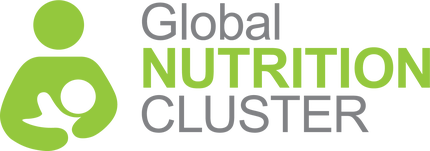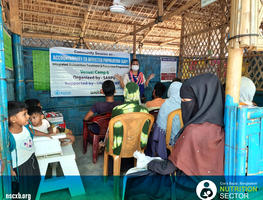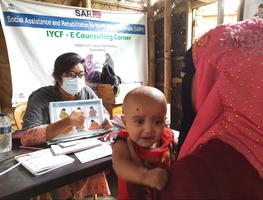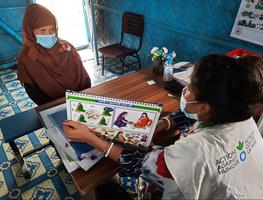Request support on coordination, information management, integration for nutrition outcomes or technical nutrition in emergencies assistance.
التماس الدعم لتنسيق التغذية وإدارة المعلومات والتغذية في حالات الطوارئ
Demander un appui pour la coordination de la nutrition, la gestion de l'information et la nutrition dans les situations d'urgence
Buscar apoyo para la coordinación de la nutrición, la gestión de la información y la nutrición en situaciones de emergencia
Solicite apoio para coordenação em nutrição, gestão de informação e nutrição em emergências
Cox’s Bazar
L1Coordination mechanism: Sector
Year of activation: 2017
NCC: P4 FT UNICEF
IMO: UNICEF NOB TA
Nutrition Officer: UNICEF UNV
Advisory:
1. CMAM advisor and TWG lead: CWW
2. IYCF advisor and TWG lead: SCI
3. AIM (Assessment and Information Management) advisor and TWG lead: ACF
Annual Report 2023
January to December 2023
Nutrition Sector partners will continue providing life-saving essential nutrition services, both curative and preventive, for the target population through the 45 rationalized integrated nutrition facilities (INFs) in the camps. Nutrition services will also be provided through other Sectors’ service centres, such as primary health care centres, hospitals, disability rehabilitation centres, and learning facilities, and through the Mother, Infant, and Young Child Feeding programme approaches. Nutrition Sector partners will continuously monitor the malnutrition status of the targeted population. Children under five with identified nutrition needs will be screened, referred, verified, and admitted to the respective nutrition programme. Children with disabilities will be referred to a disability rehabilitation program to receive stimulation therapy and to be treated jointly with nutrition, protection and disability services. The Blanket Supplementary Feeding Programme will provide preventive nutrition services to over 152,000 children under five and 38,500 PLW. The Sector will also advocate for and support other nutrition services that require inter-sectoral collaboration, including food vouchers in the selected pilot camps, and nutrition promotion and learning programmes in learning centres. The Nutrition Sector partners will expand cross-cutting programmes successfully tested in previous years, including the inclusive Early Childhood Care and Development programme for children 3-5 years, and Accountability to Affected Population (AAP). Over 3,000 PLWs with Moderate Acute Malnutrition (MAM) will be screened for anaemia during the Targeted Supplementary Feeding Programmes referrals. Severe and moderate anaemia cases will be referred to the Health’s Sexual and Reproductive Health Antenatal or Postnatal Centres nearby the nutrition facilities. The anaemia prevention programme will reach over 76,000 adolescents and 32,000 PLWs with Iron and Folic Acid supplementation. The Vitamin A supplementation campaign will reach 152,000 children aged 6-59 months and deworm 92,000 children aged 24-59 months at least twice per year.
PRIORITIZED SECTOR OBJECTIVES
To ensure equitable access and utilization of quality preventative nutrition specific services for boys and girls of 0 – 59 months, adolescent girls and pregnant and lactating women (PLW) in camps and host communities in Cox’s Bazar. (SO2, SO3)
To enhance equitable access and utilization of quality life-saving nutrition services for early detection and treatment of acute malnutrition for boys and girls of 0 – 59 months and PLW in camps and host communities in Cox’s Bazar. (SO2, SO3, SO4)
To improve capacity of nutrition actors nutrition information systems and knowledge-generation to facilitate scale-up of nutrition interventions. (SO2, SO3, SO5)
Shortage of funding is one of the major challenges that Nutrition Sector is facing now. The General Food Assistance (GFA) ration cuts started on 1st March 2023 with a reduction of the value voucher entitlement from $12 to $10 and the second phase of the reduction from $10 to $8 started on 1st June 2023. If additional funding is not received in the coming months, these entitlements may be further reduced in the future. The nutrition sector and the UN agencies are very concerned about the impact of the ration cuts on the nutrition status of vulnerable populations particularly children and pregnant and breast-feeding women. Negative impacts on nutrition have specifically been outlined as of particular concern given the already high levels of malnutrition (high stunting, wasting, micronutrient deficiencies) among the Rohingya population, which are anticipated to deteriorate over time with the GFA ration cuts.
Since the start of the ration cuts in March 2023, the general outlook from the nutrition programmes is yet to show a major impact, given that changes in nutrition status are expected to be seen over time and not suddenly. The nutrition sector and partners are working closely to strengthen community outreach programmes, strengthen the prevention of malnutrition programmes as well the quality of treatment programmes.
| Advocacy Survey | |
| Country Advocacy Strategy developed | Yes |
| Link to document | Link |
| Advocacy activities included in annual work plan | Yes |
| Specific WG leading advocacy work established | Yes |
| Preparedness | |
| Contingency plan or ERP plan developed/updated | Yes |
| Link to document | Link |
| Intersectoral Collaboration (ISC) | |
| Intersectoral projects currently under implementation | Yes |
| Clusters engaged | |
| Health Sector | |
Key Figures
(million)Funding
(million)- Children 6-59 months
- Pregnant and Lactating Women
Total Partners
JRP partners
Key Resources
list of important documents







